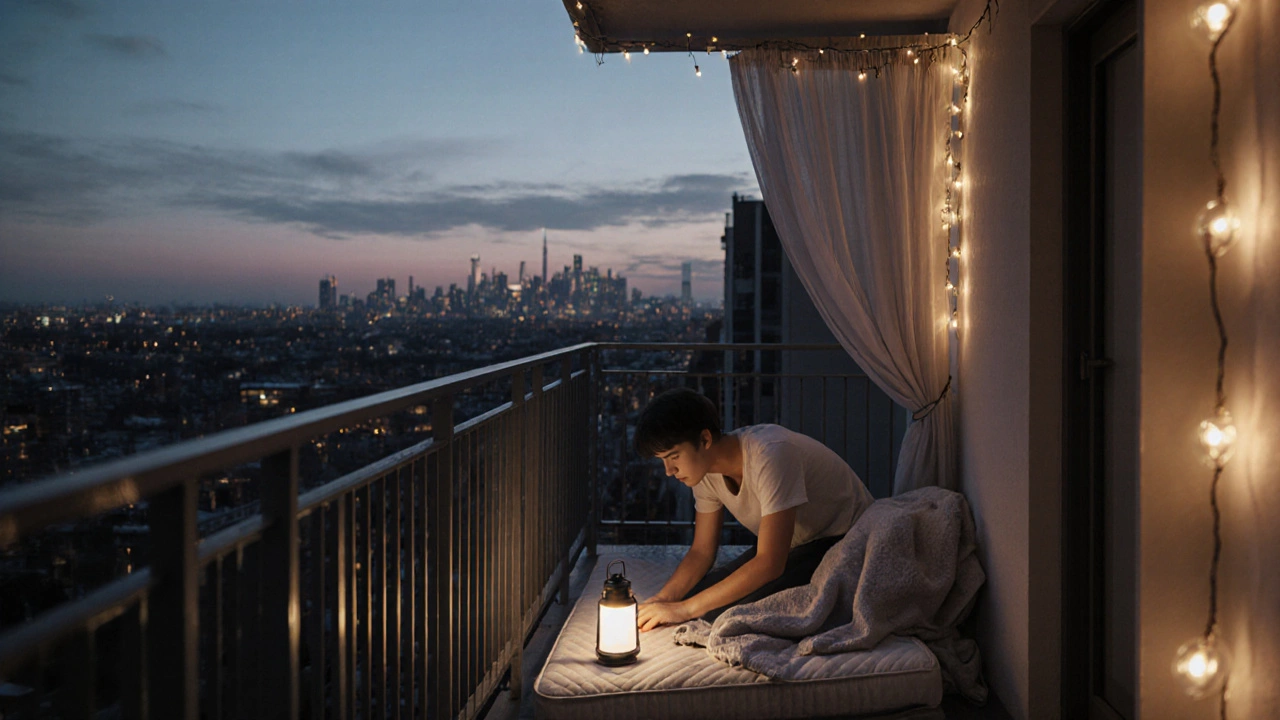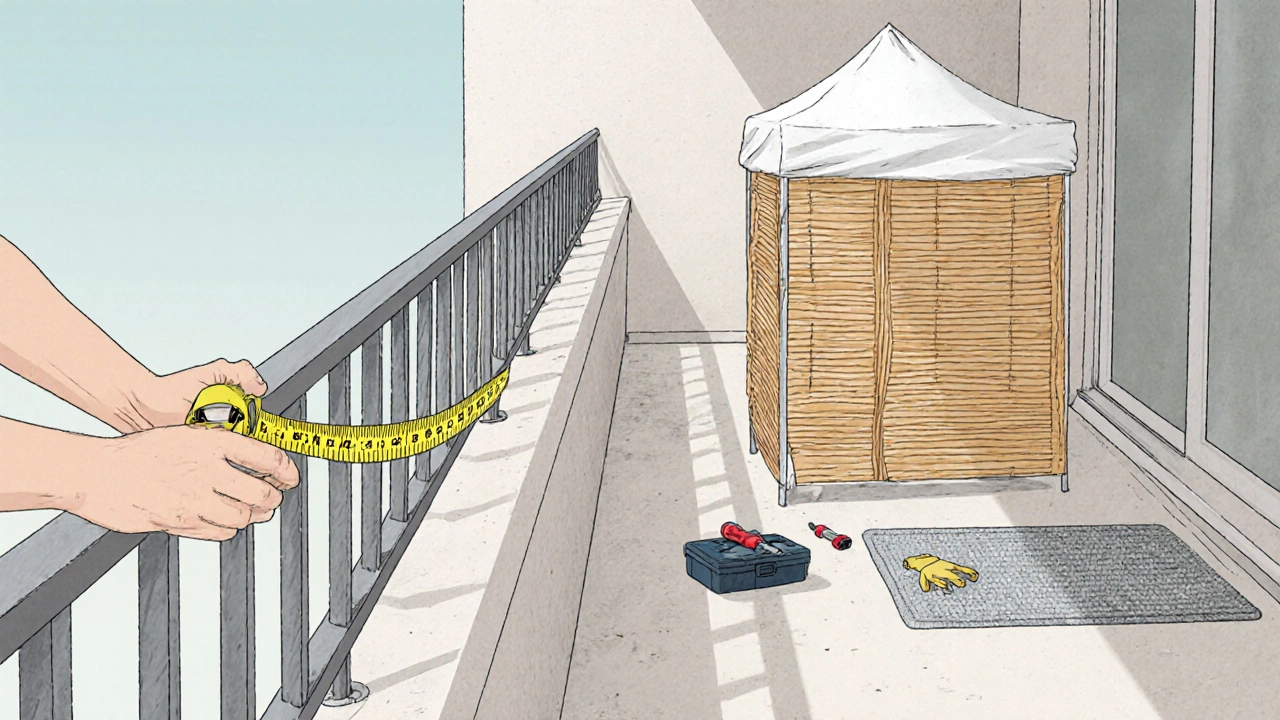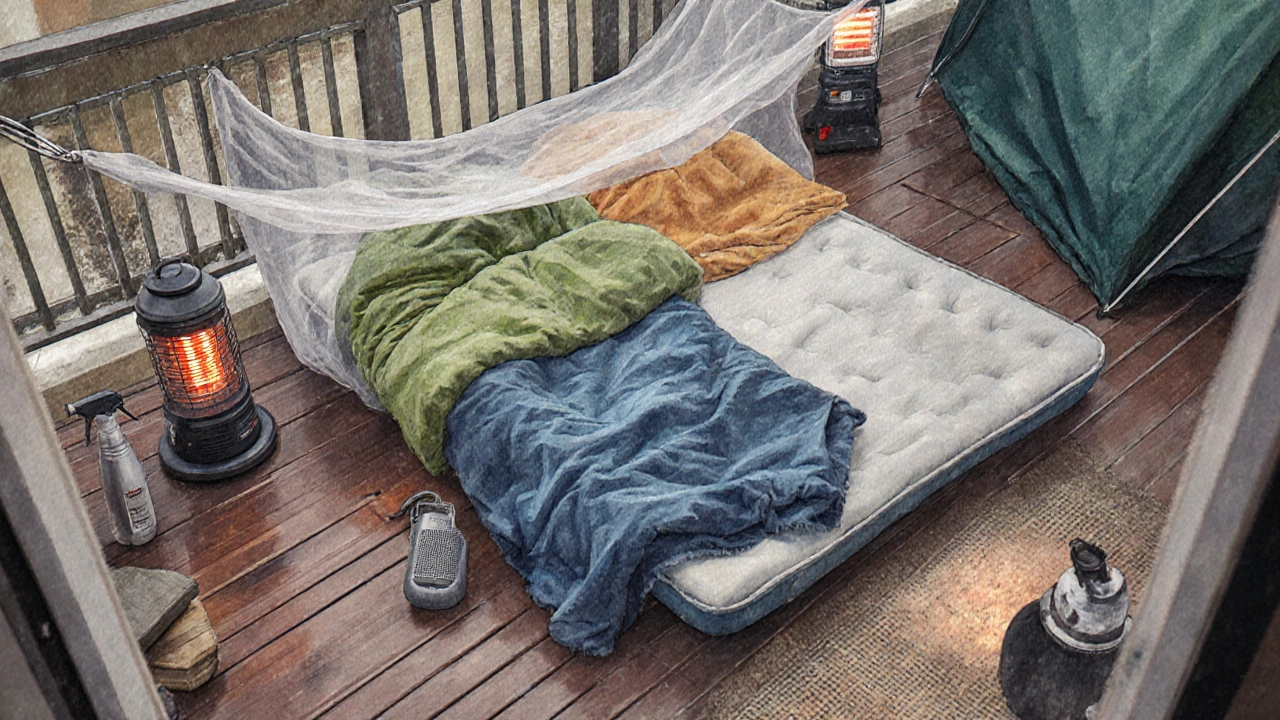How to Sleep Comfortably on a Balcony - A Practical Guide

Balcony Sleeping Gear Selector
| Gear | Space Needed | Setup Time | Weather Suitability | Cost (UK) |
|---|---|---|---|---|
| Hammock | Minimal floor space (requires two anchor points) | 5-10 minutes | Great for warm weather; needs a rain-proof cover in wet months | £30-£120 |
| Outdoor Folding Mattress | Full floor area | 2-3 minutes | Works year-round with a waterproof liner | £40-£150 |
| Sleeping Bag + Foam Pad | Very little space | 1-2 minutes | Versatile; choose a season-rated bag (summer vs. 4-season) | £25-£200 |
| Air Mattress | Full floor area | 3-5 minutes (inflate) | Needs a waterproof cover; not ideal for high winds | £50-£180 |
When you hear the phrase Balcony sleeping is the practice of using a balcony as a place to rest, nap or even spend a full night outdoors, you might picture a fancy hotel rooftop. In reality, it’s a doable, budget‑friendly way to enjoy fresh air and a change of scenery, especially if indoor space is limited. Below you’ll find everything you need to set up a safe, comfy balcony sleeping spot - from safety checks to gear choices and seasonal tweaks.
Why Try Balcony Sleeping?
Sleeping outdoors isn’t just a novelty. A quick nap under the sky can boost mood, improve circulation, and give you a gentle exposure to natural light that helps regulate your circadian rhythm. For city dwellers with cramped apartments, a balcony offers a private nook without the need for an extra room. Plus, it’s an excuse to make the most of that square‑meter you already pay for.
Safety First: Regulations and Structural Checks
Before you lay down a blanket, make sure the space is structurally sound. Most UK building codes require balcony railings to be at least 1meter high and able to support a minimum load of 250kg. If you’re unsure, consult your landlord or a building manager. Safety covers rail height, load‑bearing capacity, and secure anchoring of any sleeping gear should never be assumed.
Check for loose tiles, water pooling, or any signs of rust on metal railings. A quick tap test on the floor can reveal hollow spots that might need reinforcement. If the balcony is on the ground floor, keep an eye on local council policies - some municipalities restrict overnight stays on external balconies for fire‑safety reasons.
Creating Privacy and Weather Protection
Privacy is often the first thing people miss. Privacy can be achieved with outdoor curtains, bamboo screens, or a portable room divider that folds away when not needed. Choose breathable fabrics for summer and thicker, water‑resistant options for rainy months.
Weather protection comes next. A simple awning or a weatherproof canopy shields you from rain and harsh sun. Weather conditions dictate the type of bedding and additional insulation you’ll need. On windy evenings, a windbreak panel can prevent your sleeping setup from flapping.
Flooring matters, too. A low‑pile outdoor rug or a roll‑out foam mat adds insulation against cold concrete and keeps your gear dry. Flooring should be non‑slip, weather‑resistant, and easy to clean - think outdoor carpet tiles.

Choosing the Right Gear: Hammock, Mattress, or Sleeping Bag?
What you sleep on depends on space, budget, and personal comfort. Below is a quick comparison of the most popular options.
| Gear | Space needed | Setup time | Weather suitability | Cost (UK) |
|---|---|---|---|---|
| Hammock | Minimal floor space (requires two anchor points) | 5‑10minutes | Great for warm weather; needs a rain‑proof cover in wet months | £30‑£120 |
| Outdoor folding mattress | \nFull floor area | 2‑3minutes | Works year‑round with a waterproof liner | £40‑£150 |
| Sleeping bag + foam pad | Very little space | 1‑2minutes | Versatile; choose a season‑rated bag (summer vs. 4‑season) | £25‑£200 |
| Air mattress | Full floor area | 3‑5minutes (inflate) | Needs a waterproof cover; not ideal for high winds | £50‑£180 |
For most people, a folding outdoor mattress paired with a compact pillow hits the sweet spot - it’s easy to store, offers solid support, and works in any season when coupled with a weather‑proof cover.
Comfort Hacks: Pillows, Blankets, and Insect Defense
Invest in a low‑profile, quick‑dry pillow to avoid sagging on hot nights. A weighted blanket can add warmth in winter, but opt for a breathable fleece in summer. Insect netting is a must for an outdoor sleeping area, especially during the British summer when mosquitos and wasps appear. Clip a fine mesh canopy over your sleeping zone; it also adds a visual privacy layer.
Lighting matters for safety and ambiance. A battery‑operated LED lantern with dimming control lets you read or set a gentle wake‑up cue without disturbing neighbours.
Managing Noise and Light Pollution
City balconies can be noisy. High‑quality earplugs or a white‑noise app on a small speaker can drown out traffic. If street lights glare onto your space, hang a blackout curtain or a thick tarpaulin to create a dark sleeping environment. Noise reduction strategies include earplugs, white‑noise devices, and strategic placement of furniture can dramatically improve sleep quality.

Seasonal Adjustments
Summer: Choose a breathable hammock or a mattress with a cooling gel layer. Keep a misting spray bottle handy for extra humidity control.
Autumn: Add a fleece blanket and a portable side heater (approved for outdoor use). Check that the heater’s cord is safely routed away from the railing.
Winter: Insulate the floor with a thick rubber mat, use a 4‑season sleeping bag, and consider a small tent‑style canopy to trap heat.
Quick Checklist Before You Hit the Sack
- Verify balcony rail height (≥1m) and load capacity.
- Secure privacy screens and weatherproof cover.
- Lay down non‑slip outdoor flooring.
- Set up chosen gear (hammock, mattress, etc.) and test stability.
- Arrange pillows, blankets, and insect netting.
- Check noise‑reduction measures and lighting.
- Review seasonal accessories (heater, cooling spray, extra insulation).
- Do a final safety walk‑around: no loose cords, no sharp edges.
Frequently Asked Questions
Can I legally sleep on my balcony in the UK?
There’s no nationwide law banning overnight balcony use, but local council rules and lease agreements may restrict it. Always check your tenancy contract and any homeowner‑association guidelines before planning a night‑time stay.
How much weight can a typical balcony support?
Most residential balconies are built to hold at least 250kg (about 550lb). However, older buildings may have lower limits. If you plan to use a heavy mattress plus furniture, confirm the specific load rating with your building manager.
What’s the best sleeping gear for mixed weather?
A fold‑away outdoor mattress combined with a waterproof, season‑rated sleeping bag offers flexibility. Add a detachable, insulated blanket for chilly evenings and a light, breathable sheet for hot nights.
How can I keep insects out without sacrificing ventilation?
Install fine‑mesh insect netting that drapes over the entire sleeping area. The mesh blocks bugs while still allowing airflow. Pair it with a small fan for extra breeze if needed.
Is it safe to use an electric heater on a balcony?
Only use heaters that are certified for outdoor use, have automatic shut‑off features, and are placed on a non‑flammable surface. Keep cords away from railings and never leave the heater unattended.





